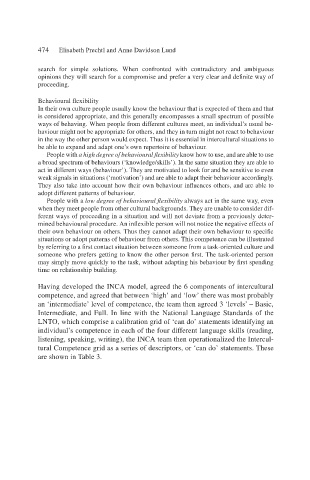Page 496 - Handbooks of Applied Linguistics Communication Competence Language and Communication Problems Practical Solutions
P. 496
474 Elisabeth Prechtl and Anne Davidson Lund
search for simple solutions. When confronted with contradictory and ambiguous
opinions they will search for a compromise and prefer a very clear and definite way of
proceeding.
Behavioural flexibility
In their own culture people usually know the behaviour that is expected of them and that
is considered appropriate, and this generally encompasses a small spectrum of possible
ways of behaving. When people from different cultures meet, an individual’s usual be-
haviour might not be appropriate for others, and they in turn might not react to behaviour
in the way the other person would expect. Thus it is essential in intercultural situations to
be able to expand and adapt one’s own repertoire of behaviour.
People with a high degree of behavioural flexibility know how to use, and are able to use
a broad spectrum of behaviours (‘knowledge/skills’). In the same situation they are able to
act in different ways (behaviour’). They are motivated to look for and be sensitive to even
weak signals in situations (‘motivation’) and are able to adapt their behaviour accordingly.
They also take into account how their own behaviour influences others, and are able to
adopt different patterns of behaviour.
People with a low degree of behavioural flexibility always act in the same way, even
when they meet people from other cultural backgrounds. They are unable to consider dif-
ferent ways of proceeding in a situation and will not deviate from a previously deter-
mined behavioural procedure. An inflexible person will not notice the negative effects of
their own behaviour on others. Thus they cannot adapt their own behaviour to specific
situations or adopt patterns of behaviour from others. This competence can be illustrated
by referring to a first contact situation between someone from a task-oriented culture and
someone who prefers getting to know the other person first. The task-oriented person
may simply move quickly to the task, without adapting his behaviour by first spending
time on relationship building.
Having developed the INCA model, agreed the 6 components of intercultural
competence, and agreed that between ‘high’ and ‘low’ there was most probably
an ‘intermediate’ level of competence, the team then agreed 3 ‘levels’ – Basic,
Intermediate, and Full. In line with the National Language Standards of the
LNTO, which comprise a calibration grid of ‘can do’ statements identifying an
individual’s competence in each of the four different language skills (reading,
listening, speaking, writing), the INCA team then operationalized the Intercul-
tural Competence grid as a series of descriptors, or ‘can do’ statements. These
are shown in Table 3.

